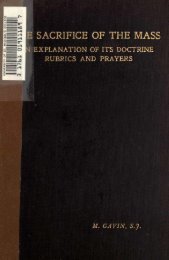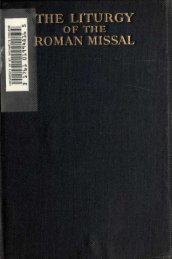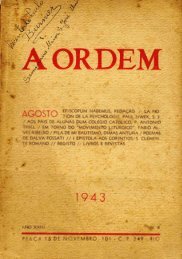E SACRIFICE OF THE MASS
E SACRIFICE OF THE MASS
E SACRIFICE OF THE MASS
You also want an ePaper? Increase the reach of your titles
YUMPU automatically turns print PDFs into web optimized ePapers that Google loves.
56<br />
<strong>THE</strong> CREED.<br />
<strong>THE</strong> CREED.<br />
After the Gospel on Sundays follows usually the<br />
sermon or explanation of the Gospel.<br />
The Gospel, then, closes the first of the two<br />
great divisions of Mass. The Mass to the end of<br />
the Gospel and sermon was called in the early ages<br />
of the Church the Missa Catechumenormn the Mass<br />
of the Catechumens from the Offertory to the Ite<br />
Missa est, Missa fidelium the Mass of the faithful.<br />
The catechumens, or those under instruction for the<br />
Church, were dismissed after the Gospel. The Dis<br />
cipline of the Secret<br />
years<br />
lasted for the first five hundred<br />
in the Church. We have already alluded in the<br />
Introductory Chapter to the Discipline of the Secret, or<br />
the custom which prevailed in the early Church of con<br />
cealing from heathens and catechumens the more secret<br />
and mysterious doctrines of the Catholic Church, either<br />
by not mentioning them at all, or by mentioning them<br />
in enigmatical language, intelligible only to those who<br />
were initiated into its meaning.<br />
" That it existed even<br />
as a rule with respect to the sacraments," says Cardinal<br />
Newman,<br />
" seems<br />
to be admitted on all hands." In<br />
times of persecution the Christians were afraid to speak<br />
openly of their doctrines and worship, from the fear of<br />
increasing their own persecution or of having their<br />
doctrines misunderstood or laughed at. They were<br />
especially anxious to keep the Blessed Eucharist and<br />
Mass secret from heathens and even catechumens.<br />
The Offertory begins the Mass of the Faithful, or of<br />
those who professed the Catholic faith. The Credo is<br />
fittingly introduced after the Gospel as a solemn act of<br />
faith in the Gospel and doctrines of Divine revelation.






